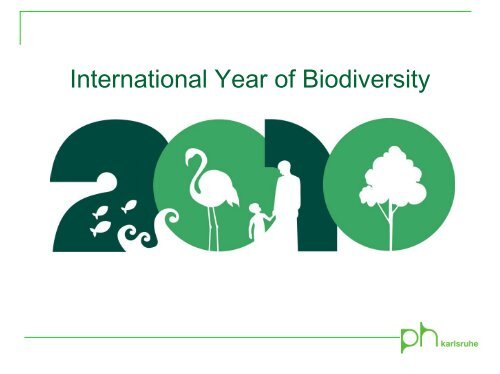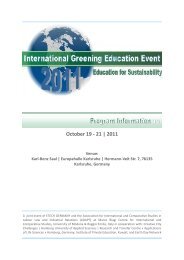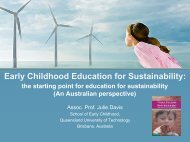Perception, Knowledge and Aesthetics of biodiversity - Etech-Center ...
Perception, Knowledge and Aesthetics of biodiversity - Etech-Center ...
Perception, Knowledge and Aesthetics of biodiversity - Etech-Center ...
Create successful ePaper yourself
Turn your PDF publications into a flip-book with our unique Google optimized e-Paper software.
International Year <strong>of</strong> Biodiversity
<strong>Perception</strong>, knowledge <strong>and</strong> aesthetics <strong>of</strong><br />
<strong>biodiversity</strong><br />
International Greening Education Event 2010<br />
29. October 2010<br />
Pr<strong>of</strong>. Dr. Petra Lindemann-Matthies <strong>and</strong> FSR Dorothee Benkowitz<br />
University <strong>of</strong> Education, Karlsruhe
Structure <strong>of</strong> the talk<br />
<strong>Perception</strong> <strong>of</strong> plant diversity<br />
Aesthetic preferences for single species<br />
Relationship between perception <strong>and</strong> aesthetic preferences<br />
Influence <strong>of</strong> education on aesthetic preferences<br />
Species richness <strong>and</strong> human aesthetic well-being<br />
Relationship between species richness <strong>of</strong> a plant community<br />
<strong>and</strong> its attractiveness to humans
Structure <strong>of</strong> the talk<br />
<strong>Perception</strong> <strong>of</strong> plant diversity<br />
Aesthetic preferences for single species<br />
Relationship between perception <strong>and</strong> aesthetic preferences<br />
Influence <strong>of</strong> education on aesthetic preferences<br />
Species richness <strong>and</strong> human aesthetic well-being<br />
Relationship between species richness <strong>of</strong> a plant community<br />
<strong>and</strong> its attractiveness to humans
How many species are there on Earth?<br />
Mean estimation Actual number Factor<br />
overestimation<br />
381 Mill. ± 1.3x10 9 1 - 50 Mill. > 7.6<br />
Dunning 1997. The missing awareness, part 2: teaching students what a billion people<br />
looks like. Conservation Biology 11
Estimates <strong>of</strong> 600 university students<br />
Mean estimation Actual number Factor<br />
overestimation<br />
381 Mill. ± 1.3x10 9 1 - 50 Mill. > 7.6<br />
Widely inaccurate ideas <strong>of</strong> number <strong>of</strong> species („many“)<br />
Dunning 1997. The missing awareness, part 2: teaching students what a billion people<br />
looks like. Conservation Biology 11
Estimates <strong>of</strong> 600 university students<br />
Mean estimation Actual number Factor<br />
overestimation<br />
381 Mill. ± 1.3x10 9 1 - 50 Mill. > 7.6<br />
Widely inaccurate ideas <strong>of</strong> number <strong>of</strong> species („many“)<br />
Assumption: Loss <strong>of</strong> <strong>biodiversity</strong> might not be perceived<br />
as a serious problem<br />
Dunning 1997. The missing awareness, part 2: teaching students what a billion people<br />
looks like. Conservation Biology 11
Estimation <strong>of</strong> plant species richness<br />
World Switzerl<strong>and</strong><br />
Alpine<br />
meadow<br />
Lawn Spruce<br />
forest<br />
100 x 100 m<br />
Beech<br />
forest<br />
200 adults und 200 grammar school students in Switzerl<strong>and</strong><br />
Lindemann-Matthies & Bose 2008. How many species are there? Public underst<strong>and</strong>ing<br />
<strong>and</strong> awareness <strong>of</strong> <strong>biodiversity</strong> in Switzerl<strong>and</strong>. Human Ecology 36
Estimation <strong>of</strong> plant species richness<br />
World Switzerl<strong>and</strong><br />
Alpine<br />
meadow<br />
Lawn Spruce<br />
forest<br />
Beech<br />
forest<br />
Minimum 200 100 10 1 2 2<br />
Maximum 1 x 10 15 4 x 10 9 1 x 10 9 2 x 10 9 1 x 10 6 1 x 10 8<br />
Median 3000000 94000 120 20 50 70<br />
Actual number 285000 3000 < 100 < 10 < 20 < 40<br />
Overestimation<br />
(median/real)<br />
10.5 31.3 1.2 2.0 2.5 1.8<br />
Lindemann-Matthies & Bose 2008. How many species are there? Public underst<strong>and</strong>ing<br />
<strong>and</strong> awareness <strong>of</strong> <strong>biodiversity</strong> in Switzerl<strong>and</strong>. Human Ecology 36
Estimation <strong>of</strong> plant species richness<br />
World Switzerl<strong>and</strong><br />
Alpine<br />
meadow<br />
Lawn Spruce<br />
forest<br />
Beech<br />
forest<br />
Minimum 200 100 10 1 2 2<br />
Maximum 1 x 10 15 4 x 10 9 1 x 10 9 2 x 10 9 1 x 10 6 1 x 10 8<br />
Median 3000000 94000 120 20 50 70<br />
Actual number 285000 3000 < 100 < 10 < 20 < 40<br />
Overestimation<br />
(median/real)<br />
<strong>Perception</strong> very different from reality<br />
10.5 31.3 1.2 2.0 2.5 1.8<br />
Loss might not be perceived as a serious problem at all<br />
Lindemann-Matthies & Bose 2008. How many species are there? Public underst<strong>and</strong>ing<br />
<strong>and</strong> awareness <strong>of</strong> <strong>biodiversity</strong> in Switzerl<strong>and</strong>. Human Ecology 36
Responses to the loss <strong>of</strong> <strong>biodiversity</strong><br />
Conceptions <strong>of</strong> the number <strong>of</strong> species present<br />
Awareness <strong>of</strong> the seriousness <strong>of</strong> the threat <strong>of</strong> extinction<br />
<strong>Knowledge</strong> about species<br />
Relationship with species
Responses to the loss <strong>of</strong> <strong>biodiversity</strong><br />
Conceptions <strong>of</strong> the number <strong>of</strong> species present<br />
Awareness <strong>of</strong> the seriousness <strong>of</strong> the threat <strong>of</strong> extinction<br />
<strong>Knowledge</strong> about species<br />
Relationship with species
“Without knowledge <strong>of</strong> <strong>and</strong> relationships with the<br />
fellow beings who share our home place, we simply<br />
do not notice what happens to them.”<br />
Weilbacher 1993. Renaissance <strong>of</strong> the naturalist. The Journal <strong>of</strong> Environmental<br />
Education 25
Why conservationists should heed Pokémon<br />
Test: 109 children from the UK (age 4 – 11 years)<br />
Raichu, Pikachu, Hitokage Zenigame, Pikachu, Mini Ryuu<br />
10 pictures each (at r<strong>and</strong>om from 150) 10 pictures each (at r<strong>and</strong>om from 150)<br />
Balmford et al. 2002. Why conservationists should heed Pokémon. Science 295
Why conservationists should heed Pokémon<br />
Result:<br />
Raichu, Pikachu, Hitokage Zenigame, Pikachu, Mini Ryuu<br />
78% recognized 53% recognized<br />
Balmford et al. 2002. Why conservationists should heed Pokémon. Science 295
Conclusions <strong>of</strong> authors<br />
<strong>Knowledge</strong> <strong>of</strong> local organisms is poor<br />
Children can remember species / species names<br />
80% <strong>of</strong> the 150 artifical „species“ correctly identified<br />
Complicated names <strong>of</strong> „species“ were remembered<br />
Producers <strong>of</strong> pokémons know much better than the<br />
educational system how to raise interest in „species“<br />
Balmford et al. 2002. Why conservationists should heed Pokémon. Science 295
Lack <strong>of</strong> knowledge about local organisms: new<br />
phenomenon or old lamentation?<br />
„The almost total ignorance about the most common<br />
plants <strong>and</strong> animals, especially among the ladies, would be<br />
ridiculous if it were not so annoying.“<br />
Guenther 1910. Der Naturschutz. Freibung i. Br.: Fehsenfeld
<strong>Knowledge</strong> about species is lost<br />
Pilgrim et al. 2007. Ecological knowledge is lost in wealthier communities <strong>and</strong><br />
countries. Environmental Science & Technology 42
<strong>Knowledge</strong> about species is lost<br />
<strong>Knowledge</strong> about species no longer necessary for survival<br />
Pilgrim et al. 2007. Ecological knowledge is lost in wealthier communities <strong>and</strong><br />
countries. Environmental Science & Technology 42
High signal value<br />
Urtica dioica<br />
Toxicodendron radicans<br />
> 90% <strong>of</strong> study participants
Reasons for loss <strong>of</strong> knowledge<br />
Increasing loss <strong>of</strong> 'wild' habitats for outdoor play <strong>and</strong><br />
nature investigation activities (Louv 2006)<br />
Increasing parental concern: traffic danger, violence<br />
(Hüttenmoser 1996; Valentine & McKendrick 1997; Prezza et al. 2005; Robertson 2006)<br />
Increasing TV-, video consumption; children spend more<br />
time in the house than outside (McKendrick et al. 2000; Aitken 2001)
Reasons for loss <strong>of</strong> knowledge<br />
Increasing loss <strong>of</strong> 'wild' habitats for outdoor play <strong>and</strong><br />
nature investigation activities (Louv 2006)<br />
Increasing parental concern: traffic danger, violence<br />
(Hüttenmoser 1996; Valentine & McKendrick 1997; Prezza et al. 2005; Robertson 2006)<br />
Increasing TV-, video consumption; children spend more<br />
time in the house than outside (McKendrick et al. 2000; Aitken 2001)<br />
US: Children watch more than 4 hours daily TV <strong>and</strong><br />
spend less than 1 hour outside (Orr 2002)
Reasons for loss <strong>of</strong> knowledge<br />
Increasing loss <strong>of</strong> 'wild' habitats for outdoor play <strong>and</strong><br />
nature investigation activities (Louv 2006)<br />
Increasing parental concern: traffic danger, violence<br />
(Hüttenmoser 1996; Valentine & McKendrick 1997; Prezza et al. 2005; Robertson 2006)<br />
Increasing TV-, video consumption; children spend more<br />
time in the house than outside (McKendrick et al. 2000; Aitken 2001)<br />
Decrease <strong>of</strong> nature-related activities <strong>and</strong> fieldwork in<br />
school (Barker et al. 2002)
Structure <strong>of</strong> the talk<br />
<strong>Perception</strong> <strong>of</strong> plant diversity<br />
Aesthetic preferences for single species<br />
Relationship between perception <strong>and</strong> aesthetic preferences<br />
Influence <strong>of</strong> education on aesthetic preferences<br />
Species richness <strong>and</strong> human aesthetic well-being<br />
Relationship between species richness <strong>of</strong> a plant community<br />
<strong>and</strong> its attractiveness to humans
Attractive plants<br />
Plants with large, bright-coloured flowers or leaves<br />
Japanese Maple (Acer palmatum) favourite garden tree<br />
Genetic predisposition:<br />
Colour might have signalled „ripe fruits“<br />
Heerwagen & Orians 1993. Humans, habitats <strong>and</strong> aesthetics. In Kellert & Wilson<br />
(eds.) The Biophilia Hypothesis
Top 5 in Switzerl<strong>and</strong> in view <strong>of</strong> 6700 children<br />
Cat<br />
Dog<br />
Horse<br />
Squirrel<br />
Rabbit<br />
Rose<br />
Tulip<br />
Daffodil<br />
D<strong>and</strong>elion<br />
Daisy<br />
Lindemann-Matthies 2005. ‘Loveable’ mammals <strong>and</strong> ‘lifeless’ plants. International<br />
Journal <strong>of</strong> Science Education 27
Can aesthetic preferences be influenced?<br />
Attractiveness <strong>of</strong> an organism has been found to be the main<br />
reason for children <strong>and</strong> adults to protect a species!<br />
Ashworth et al. 1995. Conservation <strong>of</strong> endangered species: what do children think?<br />
Environmental Education <strong>and</strong> Information 14
Structure <strong>of</strong> the talk<br />
<strong>Perception</strong> <strong>of</strong> plant diversity<br />
Aesthetic preferences for single species<br />
Relationship between perception <strong>and</strong> aesthetic preferences<br />
Influence <strong>of</strong> education on aesthetic preferences<br />
Species richness <strong>and</strong> human aesthetic well-being<br />
Relationship between species richness <strong>of</strong> a plant community<br />
<strong>and</strong> its attractiveness to humans
6800 children (8-14 years old) were asked:<br />
Which plants do you recognize on your way to school?<br />
Write down as many as you can.<br />
Which animals do you recognize on your way to school?<br />
Write down as many as you can.
6800 children (8-14 years old) were asked:<br />
Which plants do you recognize on your way to school?<br />
Write down as many as you can.<br />
Which animals do you recognize on your way to school?<br />
Write down as many as you can.<br />
Write down the plant you think to be most attractive.<br />
Write down the animal you think to be most attractive.
<strong>Perception</strong> <strong>and</strong> preferences<br />
Relationship between<br />
perception <strong>of</strong> <strong>and</strong><br />
preferences for species<br />
Appreciation <strong>of</strong> the plant group<br />
Proportion <strong>of</strong> children (%)<br />
Appreciation <strong>of</strong> the animal group<br />
Proportion <strong>of</strong> children (%)<br />
100<br />
80<br />
60<br />
40<br />
20<br />
0<br />
100<br />
80<br />
60<br />
40<br />
20<br />
0<br />
(a) Wild plants <strong>of</strong> Switzerl<strong>and</strong> (b) Garden or decorative plants<br />
0 2 4 6 8 10<br />
100<br />
80<br />
60<br />
40<br />
20<br />
0<br />
0 2 4 6 8 10<br />
Mean number <strong>of</strong> taxa listed per class<br />
(c) Wild animals <strong>of</strong> Switzerl<strong>and</strong> (d) Pet or useful animals<br />
0 2 4 6 8 10<br />
r = 0.41*** r = 0.29***<br />
100<br />
r = 0.48*** r = 0.29***<br />
80<br />
60<br />
40<br />
20<br />
0<br />
0 2 4 6 8 10<br />
Mean number <strong>of</strong> taxa listed per class<br />
Lindemann-Matthies 2005. ‘Loveable’ mammals <strong>and</strong> ‘lifeless’ plants. International Journal <strong>of</strong> Science<br />
Education 27
Educational programme<br />
Aim: Increase perception <strong>of</strong> local<br />
wild plant <strong>and</strong> animal species<br />
Outdoor investigation activities<br />
Experience nature with all senses
Experience <strong>of</strong> nature with all senses
Learning in familiar environment is effective<br />
"I got to know lichens. In the<br />
beginning I thought they were<br />
all chewing gum.“<br />
12 year old boy after investigating a stone wall
Education can influence aesthetic preferences<br />
Change in appreciation <strong>of</strong> wild plants<br />
Proportion <strong>of</strong> children (%)<br />
100<br />
80<br />
60<br />
40<br />
20<br />
0<br />
-20<br />
-40<br />
r = 0.32***<br />
-4 0 4 8 12<br />
Change in mean number <strong>of</strong> wild plants listed<br />
Aesthetic preferences for local wild plant (<strong>and</strong> animal) species increased with<br />
familiarity<br />
Lindemann-Matthies 2005. ‘Loveable’ mammals <strong>and</strong> ‘lifeless’ plants. International<br />
Journal <strong>of</strong> Science Education 27
Efforts <strong>of</strong> teachers were rewarded<br />
Preferences for local wild<br />
plant <strong>and</strong> animal species<br />
increased with number<br />
<strong>of</strong> lessons taught<br />
Change in proportion <strong>of</strong> children<br />
favouring wild plants (%)<br />
Change in proportion <strong>of</strong> children<br />
favouring wild animals (%)<br />
100<br />
75<br />
50<br />
25<br />
0<br />
-25<br />
-50<br />
-75<br />
-100<br />
0.1 1 10 100<br />
100<br />
75<br />
50<br />
25<br />
0<br />
-25<br />
-50<br />
-75<br />
(a) Wild plants <strong>of</strong> Switzerl<strong>and</strong> (b) Decorative or garden plants<br />
100<br />
r = 0.46***<br />
(c) Wild animals <strong>of</strong> Switzerl<strong>and</strong> (d) Pet animals<br />
r = 0.20***<br />
-100<br />
0.1 1 10 100<br />
Change in proportion <strong>of</strong> children<br />
favouring decorative or garden plants (%)<br />
Number <strong>of</strong> lessons taught (log-scale)<br />
Change in proportion <strong>of</strong> children<br />
favouring pet animals (%)<br />
75<br />
50<br />
25<br />
-25<br />
-50<br />
-75<br />
-100<br />
0.1 1 10 100<br />
100<br />
75<br />
50<br />
25<br />
-25<br />
-50<br />
-75<br />
-100<br />
0.1 1 10 100<br />
Number <strong>of</strong> lessons taught (log-scale)<br />
0<br />
0<br />
r = 0.36***<br />
r = 0.22***<br />
Lindemann-Matthies 2006. Investigating nature on the way to school. International Journal <strong>of</strong> Science<br />
Education 28
Summary<br />
Widely inaccurate ideas <strong>of</strong> number <strong>of</strong> species<br />
<strong>Knowledge</strong> <strong>of</strong> local organisms is poor, at least in highly<br />
industrialized countries<br />
<strong>Perception</strong> <strong>of</strong> <strong>biodiversity</strong> is directed towards few<br />
„loveable“ organisms<br />
Outdoor investigation activities in near-by natural places<br />
can increase students' perception <strong>and</strong> knowledge <strong>of</strong> species<br />
Link between perception <strong>and</strong> preferences => foster interest<br />
in <strong>and</strong> relationship with inconspicuous wild species
Structure <strong>of</strong> the talk<br />
<strong>Perception</strong> <strong>of</strong> plant diversity<br />
Aesthetic preferences for single species<br />
Relationship between perception <strong>and</strong> aesthetic preferences<br />
Influence <strong>of</strong> education on aesthetic preferences<br />
Species richness <strong>and</strong> human aesthetic well-being<br />
Relationship between species richness <strong>of</strong> a plant community<br />
<strong>and</strong> its attractiveness to humans
Nature (green trees) influences well-being<br />
Two groups <strong>of</strong> patients after gall<br />
bladder surgery<br />
Recovering in comparable rooms, but<br />
(a) view to a brick wall <strong>and</strong> (b) view to<br />
green trees<br />
Information taken from records:<br />
- Number <strong>of</strong> days <strong>of</strong> hospitalization<br />
- Number <strong>and</strong> strength <strong>of</strong> medizine<br />
each day<br />
- Complications<br />
- Nurses notes (other information)<br />
Ulrich 1984. View through a window may influence recovery from surgery. Science 224
Nature (green trees) influences well-being<br />
Patients with tree view had shorter postoperative hospital stays<br />
Took fewer strong analgesic doses <strong>and</strong> showed fewer complications<br />
Could leave the hospital earlier<br />
Ulrich 1984. View through a window may influence recovery from surgery. Science 224
Species richness influences psychological wellbeing<br />
Perceived stress recovery<br />
Transect <strong>of</strong> greenspaces<br />
through city <strong>of</strong> Sheffield<br />
Estimation <strong>of</strong> plant species<br />
richness in greenspaces<br />
300 interviews in situ<br />
Opinion on different statements<br />
(scale 1 – 4), e.g. recovery from<br />
stress when looking at a site<br />
Fuller et al. 2007. Psychological benefits <strong>of</strong> greenspace increase with <strong>biodiversity</strong>.<br />
Biology Letters 3
Species richness influences psychological wellbeing<br />
Perceived stress recovery<br />
Transect <strong>of</strong> greenspaces<br />
through city <strong>of</strong> Sheffield<br />
Estimation <strong>of</strong> plant species<br />
richness in greenspaces<br />
300 interviews in situ<br />
Opinion on different statements<br />
(scale 1 – 4), e.g. recovery from<br />
stress when looking at a site<br />
Does plant species richness influence our aesthetic well-being?<br />
Fuller et al. 2007. Psychological benefits <strong>of</strong> greenspace increase with <strong>biodiversity</strong>.<br />
Biology Letters 3
Structure <strong>of</strong> the talk<br />
<strong>Perception</strong> <strong>of</strong> plant diversity<br />
Aesthetic preferences for single species<br />
Relationship between perception <strong>and</strong> aesthetic preferences<br />
Influence <strong>of</strong> education on aesthetic preferences<br />
Species richness <strong>and</strong> human aesthetic well-being<br />
Relationship between species richness <strong>of</strong> a plant community<br />
<strong>and</strong> its attractiveness to humans
Aesthetic responses <strong>of</strong> the public to different diversity<br />
Manipulative experiments<br />
Field studies<br />
Photo surveys<br />
Survey in private gardens
Aesthetic responses <strong>of</strong> the public to different diversity<br />
Manipulative experiments<br />
Field studies<br />
Photo surveys<br />
Survey in private gardens
Manipulative experiments<br />
Selected: 67 typical grassl<strong>and</strong> species<br />
52 herbs und 15 grasses<br />
1500 plants in pots<br />
Plants arranged as "meadows" <strong>of</strong> different diversity
Study design<br />
Presentation <strong>of</strong> 5 meadows at the same time<br />
Experiment 1: 1, 2, 4, 8, 16 species<br />
Experiment 2: 4, 8, 16, 32, 64 species<br />
Same evenness<br />
4 species 32 species 16 species 64 species 8 species<br />
To differentiate between effects <strong>of</strong> species diversity <strong>and</strong><br />
species identity: each day a different combination <strong>of</strong> plants<br />
Design similar to <strong>biodiversity</strong> experiments: Hector et al. 1999. Plant diversity <strong>and</strong><br />
productivity in European grassl<strong>and</strong>s. Science 286
Example <strong>of</strong> a meadow arrangement
Correlative field studies<br />
Canton Zurich Canton Grisons<br />
2 x 2 m 1 x 25 m
Study participants (n = 1500) should:<br />
Estimate number <strong>of</strong> plant species<br />
in each "meadow"<br />
Assess their attractiveness:<br />
Experiments: Ranking (1 - 5)<br />
Field studies: Rating (1 - 6)
<strong>Perception</strong> <strong>of</strong> plant species richness<br />
Experiment 1 Experiment 2<br />
Field study Zurich Field study Grisons<br />
Lindemann-Matthies et al. 2010. Experimental evidence for human preference <strong>of</strong><br />
<strong>biodiversity</strong> in grassl<strong>and</strong> ecosystems. Biological Conservation 143
<strong>Perception</strong> <strong>of</strong> plant species richness<br />
Experiment 1 Experiment 2<br />
Field study Zurich Field study Grisons<br />
People are able to<br />
distinguish between<br />
species-poor <strong>and</strong><br />
species-rich plant<br />
communities<br />
They overestimate<br />
species richness in<br />
low-diversity plots<br />
With increasing<br />
true species richness,<br />
the deviation<br />
increases
Aesthetic preferences<br />
Experiment 1 Experiment 2<br />
Field study Zurich Field study Grisons<br />
Lindemann-Matthies et al. 2010. Experimental evidence for human preference <strong>of</strong><br />
<strong>biodiversity</strong> in grassl<strong>and</strong> ecosystems. Biological Conservation 143
Aesthetic preferences<br />
Experiment 1 Experiment 2<br />
Field study Zurich Field study Grisons<br />
Aesthetic appreciation<br />
increases<br />
with increasing<br />
plant species<br />
richness
Aesthetic preferences children<br />
Appreciation (mean rank)<br />
1<br />
2<br />
3<br />
4<br />
5<br />
Adults<br />
Children<br />
1 2 4 8 16<br />
True species richness (log-scale)<br />
Already 6-year old children like species-rich meadows best<br />
=> Inherent appreciation <strong>of</strong> species richness
Effect <strong>of</strong> perceived <strong>and</strong> true species richness<br />
Additional effect <strong>of</strong> true species richness => unconscious effect?<br />
Lindemann-Matthies et al. 2010. Experimental evidence for human preference <strong>of</strong><br />
<strong>biodiversity</strong> in grassl<strong>and</strong> ecosystems. Biological Conservation 143
Influence <strong>of</strong> individual species on appreciation<br />
Leucanthemum vulgare (positiv)<br />
Papaver rhoeas (positiv)<br />
Linaria vulgaris (positiv)<br />
Lolium perenne (negativ)<br />
=> Species richness more important than species identity
Favourite meadows<br />
Presentation <strong>of</strong> all plants used in<br />
experiments (800 plants, 54<br />
species) in Botanical Garden<br />
Zurich<br />
150 visitors were invited to create<br />
an attractive meadow (25 pots)
Influence <strong>of</strong> individual species on appreciation<br />
40<br />
30<br />
20<br />
10<br />
0<br />
Mean = 17.2 species<br />
1 - 5 6 - 10 11 - 15 16 - 20 21 - 25<br />
Number <strong>of</strong> plant species<br />
Assemblages (%)<br />
12<br />
10<br />
8<br />
6<br />
4<br />
2<br />
0<br />
Mean = 34.2%<br />
0 20 40 60 80 100<br />
Proportion <strong>of</strong> flowering plants per assembled meadow (%)<br />
Lindemann-Matthies & Bose 2007. Species richness, structural diversity <strong>and</strong> species composition in<br />
meadows created by visitors <strong>of</strong> a botanical garden in Switzerl<strong>and</strong>. L<strong>and</strong>scape <strong>and</strong> Urban Planning 79
Meadows were<br />
Species-rich <strong>and</strong> rich in<br />
structural diversity<br />
Green matrix ...<br />
With some colourful flowers<br />
Lindemann-Matthies & Bose 2007. Species richness, structural diversity <strong>and</strong> species composition in<br />
meadows created by visitors <strong>of</strong> a botanical garden in Switzerl<strong>and</strong>. L<strong>and</strong>scape <strong>and</strong> Urban Planning 79
Summary<br />
Species richness <strong>of</strong> a community is powerful indicator <strong>of</strong> its<br />
aesthetic appeal to people<br />
No influence <strong>of</strong> socio-demographic factors on people’s<br />
aesthetic valuation <strong>of</strong> plant communities<br />
Presence <strong>of</strong> some species had slight additional influence<br />
Argument for the conservation <strong>of</strong> species-rich communities<br />
in agricultural l<strong>and</strong> <strong>and</strong> settlement areas
Summary
Summary
Summary
Question<br />
Does schoolgarden work increase children‘s perception <strong>and</strong><br />
appreciation <strong>of</strong> <strong>biodiversity</strong>?
Outline<br />
1. School gardening <strong>and</strong> the CBD<br />
2. School gardening as an access to<br />
<strong>biodiversity</strong><br />
3. Issue <strong>of</strong> research<br />
4. Design<br />
5. Results<br />
6. Summary<br />
7. Conclusion
1. School gardening <strong>and</strong> CBD<br />
CBD – Education <strong>and</strong><br />
Information<br />
Better <strong>biodiversity</strong><br />
education would meet one<br />
<strong>of</strong> the goals set out in the<br />
Convention (UNEP 2000)
1. School gardening <strong>and</strong> CBD<br />
CBD – Education <strong>and</strong><br />
Information<br />
Better <strong>biodiversity</strong><br />
education would meet one<br />
<strong>of</strong> the goals set out in the<br />
Convention (UNEP 2000)<br />
Vision <strong>of</strong> the German<br />
national strategy: Raising<br />
people’s appreciation <strong>of</strong><br />
biological diversity (BMU 2008)
Integration in the Educational System<br />
Affiliation with the UN-Decade<br />
„Education for Sustainable<br />
Development“ (BMU 2008)
Integration in the Educational System<br />
Affiliation with the UN-Decade<br />
„Education for Sustainable<br />
Development“ (BMU 2008)<br />
One appropriate action:<br />
promotion <strong>of</strong> school gardens (ib.)
Integration in the Educational System<br />
Affiliation with the UN-Decade<br />
„Education for Sustainable<br />
Development“ (BMU 2008)<br />
One appropriate action:<br />
promotion <strong>of</strong> school gardens (ib.)<br />
<strong>Perception</strong> <strong>and</strong> appreciation <strong>of</strong> species-richness should be<br />
promoted in childhood (Kahn 2002, Lindemann-Matthies 1999)
Results <strong>of</strong> previous studies:<br />
H<strong>and</strong>s-on experience with nature …<br />
… fosters the readiness to act ecosensitive<br />
(Lude 2001, Bögeholz 1999)
Results <strong>of</strong> previous studies:<br />
H<strong>and</strong>s-on experience with nature …<br />
… fosters the readiness to act ecosensitive<br />
(Lude 2001, Bögeholz 1999)<br />
… raises the perception <strong>and</strong> knowledge <strong>of</strong> plant species<br />
(Pohl & Schrenk 2005, Lindemann-Matthies 1999, 2010)
Results <strong>of</strong> previous studies:<br />
H<strong>and</strong>s-on experience with nature …<br />
… fosters the readiness to act ecosensitive<br />
(Lude 2001, Bögeholz 1999)<br />
… raises the perception <strong>and</strong> knowledge <strong>of</strong> plant species<br />
(Pohl & Schrenk 2005, Lindemann-Matthies 1999, 2010)<br />
Without instruction knowledge <strong>of</strong> species is very limited<br />
(Jäkel & Schaer 2004, Hesse 2002)
Results <strong>of</strong> previous studies:<br />
H<strong>and</strong>s-on experience with nature …<br />
… fosters the readiness to act ecosensitive<br />
(Lude 2001, Bögeholz 1999)<br />
… raises the perception <strong>and</strong> knowledge <strong>of</strong> plant species<br />
(Pohl & Schrenk 2005, Lindemann-Matthies 1999, 2010)<br />
Without instruction knowledge <strong>of</strong> species is very limited<br />
(Jäkel & Schaer 2004, Hesse 2002)<br />
After regular work in school gardens over a period <strong>of</strong> only<br />
four years children were able to specify up to 75 plants<br />
(Schwier 2001)
Consequences:<br />
Childhood is an appropriate<br />
starting point in the search<br />
for long-term solutions to<br />
species loss <strong>and</strong> habitat<br />
degradation (Kahn 2002)
Consequences:<br />
Childhood is an appropriate<br />
starting point in the search<br />
for long-term solutions to<br />
species loss <strong>and</strong> habitat<br />
degradation (Kahn 2002)<br />
Children need opportunities to assume responsibility for<br />
environmental areas where they can have a direct impact<br />
on it (Helldén 1997)
2. School gardening as an access to<br />
<strong>biodiversity</strong>
Number <strong>of</strong> plant species in school gardens<br />
School garden Number <strong>of</strong><br />
Species<br />
(Inngauer 2008)<br />
Area (m 2 ) Plant Family<br />
Garden A 76 214 35<br />
Garden B 111 136 43<br />
Garden C - flowerbed 90 421 37<br />
Garden C - herbary 52 212 27<br />
University Garden 336 1450 76<br />
Aggregated 406 / 83
School garden as authentic learning environment<br />
Learning as an…<br />
• active<br />
• self-regulated<br />
• constructive<br />
• emotional<br />
• situational<br />
•social<br />
…process<br />
(Reinmann & M<strong>and</strong>l 2006)
3. Issue <strong>of</strong> research<br />
Does school gardening produce an effect on the<br />
perception <strong>and</strong> appreciation <strong>of</strong> plant <strong>biodiversity</strong>?
Selected hypotheses:<br />
School gardening …<br />
1. … raises the perception <strong>of</strong> plant species
Selected hypotheses:<br />
School gardening …<br />
1. … raises the perception <strong>of</strong> plant species<br />
2. … fosters the aesthetic valuation <strong>of</strong> species-richness
Selected hypotheses:<br />
School gardening …<br />
1. … raises the perception <strong>of</strong> plant species<br />
2. … fosters the aesthetic valuation <strong>of</strong> species-richness<br />
3. … increases the knowledge <strong>of</strong> plant species
Selected hypotheses:<br />
School gardening …<br />
1. … raises the perception <strong>of</strong> plant species<br />
2. … fosters the aesthetic valuation <strong>of</strong> species-richness<br />
3. … increases the knowledge <strong>of</strong> plant species<br />
4. Factors other than school education are important to<br />
achieve knowledge <strong>of</strong> species (e.g. parents, media)
Selected hypotheses:<br />
School gardening …<br />
1. … raises the perception <strong>of</strong> plant species<br />
2. … fosters the aesthetic valuation <strong>of</strong> species-richness<br />
3. … increases the knowledge <strong>of</strong> plant species<br />
4. Factors other than school education are important to<br />
achieve knowledge <strong>of</strong> species (e.g. parents, media)<br />
5. Taxonomic knowledge positively influences the<br />
estimation <strong>of</strong> plant species richness in a meadow
4. Design<br />
The „meadow experiment“<br />
Meadow-like arrays <strong>of</strong> different diversity:<br />
(49 flowerpots per box)<br />
8 2 16 4
8-species-meadow<br />
A 18 Alopecurus pratensis<br />
8 Dactylis glomerata<br />
4 Arrhenatherum elatius<br />
4 Veronica chamaedrys<br />
3 Trifolium pratense<br />
3 Leucanthemum vulgare<br />
5 Lychnis flos-cuculi<br />
4 Vicia cracca
Methods<br />
Structured one-to-one interviews<br />
St<strong>and</strong>ardised questionnaires with open <strong>and</strong> closed-ended<br />
questions<br />
Child-oriented activities (meadow experiment, sorting <strong>of</strong><br />
plants according to likeness or development stage)<br />
Videotaping<br />
Transcription (VIDEOGRAPH, IPN 2008)<br />
Data interpretation (SPSS 18)
Study participants<br />
n = 136 urban rural <br />
with* 66 55 11 37 29<br />
without* 70 56 14 43 27<br />
Primary school children with/without *school garden experience
Study design<br />
March / May 2007<br />
14 months<br />
May / July 2008<br />
Test group Control group<br />
Pretest<br />
+ teacher<br />
School gardening<br />
+ protocol<br />
Posttest<br />
+ teachers<br />
+ parents<br />
Pretest<br />
+ teacher<br />
Classroom instruction<br />
+ protocol<br />
Posttest<br />
+ teachers<br />
+ parents
The meadow experiment<br />
4 species<br />
11 species
5. Results<br />
<strong>Perception</strong> <strong>of</strong> species (posttest)<br />
N = 136<br />
* school garden experience
St<strong>and</strong>ard deviation <strong>of</strong> the difference<br />
N = 136<br />
* school garden<br />
experience
Favourite meadow<br />
N = 136<br />
Effects: choice <strong>of</strong> pretest***, number <strong>of</strong> bloomers***, cv growth hight***, SG***<br />
r 2 = 0.5
Favourite meadow – without garden experience<br />
N = 70<br />
Effects: choice in the pretest***, number <strong>of</strong> bloomers***, cv growth height***, SG***<br />
r 2 = 0.5
Favourite meadow – with garden experience<br />
N = 66<br />
Effects: choice in pretest***, bloomers***, cv <strong>of</strong> growth height***, time spend<br />
in SG**, diversity in the SG*** r 2 = 0.87
Favourite meadow – boys <strong>and</strong> girls<br />
Children with school garden experience<br />
N = 66
Reasons for their choice<br />
Other: growth height, grass …<br />
N = 136
10.11.2010
Appreciation <strong>of</strong> the meadows<br />
☺<br />
<br />
<br />
N = 136<br />
Effects: number <strong>of</strong> species***, number <strong>of</strong> bloomers**, growth height***<br />
16-species-mark * SG: p < .035*<br />
*school garden<br />
experience
Reasons for the evaluation <strong>of</strong> the 16 speciesmeadow<br />
SG * diversity p < .06<br />
* school garden experience<br />
N = 61
<strong>Knowledge</strong> <strong>of</strong> plant species (posttest)<br />
<strong>Knowledge</strong> * SG p < .015*<br />
N = 136<br />
* school<br />
garden<br />
experience<br />
Effects: precognition***, plant details***, parents*, SG**, books about plants*<br />
r 2 = 0.7
<strong>Knowledge</strong> <strong>of</strong> plant species <strong>and</strong> estimate<br />
Estimate <strong>of</strong> the 16 species * knowledge <strong>of</strong> plants p < .025*<br />
N = 136
6. Summary<br />
1. School gardening has a slight positive influence on the<br />
perception <strong>of</strong> plant diversity
6. Summary<br />
1. School gardening has a slight positive influence on the<br />
perception <strong>of</strong> plant diversity<br />
2. School gardening fosters the aesthetic appreciation <strong>of</strong><br />
species richness (p < 0.001)
6. Summary<br />
1. School gardening has a slight positive influence on the<br />
perception <strong>of</strong> plant diversity<br />
2. School gardening fosters the aesthetic appreciation <strong>of</strong><br />
species richness (p < 0.001)<br />
Most children preferred species-rich arrangements<br />
Test group scored significantly higher in preference for<br />
the species-rich arrangements than control group<br />
Test group explained their preference with species<br />
richness
3. School gardening fosters taxonomic knowledge<br />
(significant difference between test <strong>and</strong> control<br />
group)
3. School gardening fosters taxonomic knowledge<br />
(significant difference between test <strong>and</strong> control<br />
group)<br />
4. Factors other than school play a significant role in<br />
fostering knowledge <strong>of</strong> plant names (parents, books<br />
about plants)
3. School gardening fosters taxonomic knowledge<br />
(significant difference between test <strong>and</strong> control<br />
group)<br />
4. Factors other than school play a significant role in<br />
fostering knowledge <strong>of</strong> plant names (parents, books<br />
about plants)<br />
5. With increasing taxonomic knowledge, deviation<br />
between real <strong>and</strong> estimated number <strong>of</strong> plant species<br />
decreases (8 <strong>and</strong> 16 species-meadows)
7. Conclusion<br />
With time, school-garden work can foster the perception<br />
<strong>and</strong> appreciation <strong>of</strong> plant diversity.
7. Conclusion<br />
With time, school-garden work can foster the perception<br />
<strong>and</strong> appreciation <strong>of</strong> plant diversity.<br />
We need to engage<br />
children in constructivist<br />
environmental education to<br />
maximize their exploration<br />
<strong>of</strong> <strong>and</strong> interaction with the<br />
nature that still exists within<br />
their purview.<br />
(Kahn 2002)
Thank you for your attention!
















